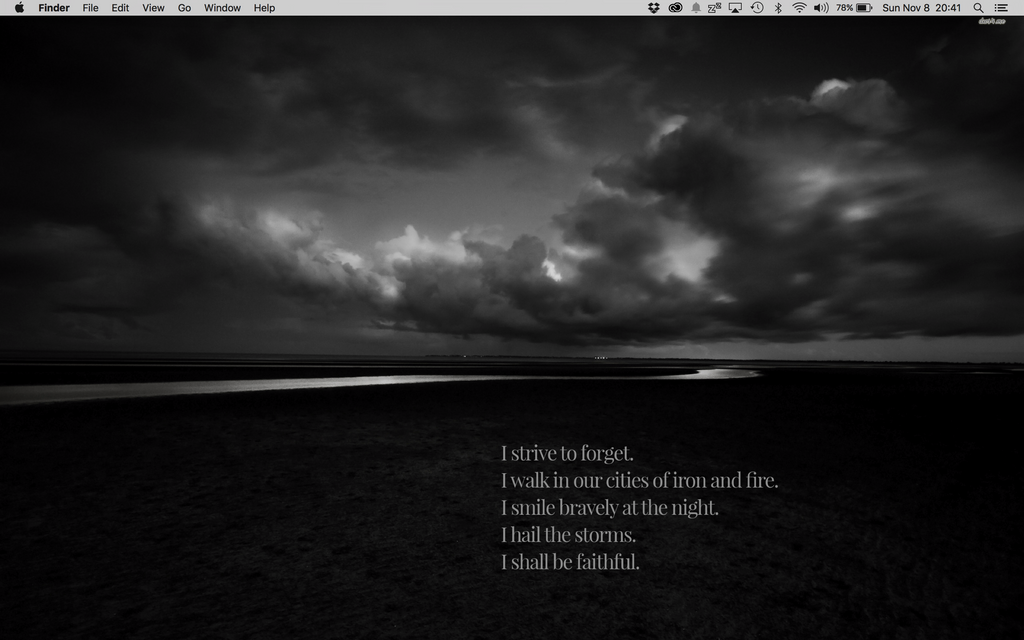I Want to Paint It Black: An Aesthetic Case for Ford's Favorite Color
Henry Ford supposedly once said, of his Model T’s color options: “A customer can have a car painted any color he wants—so long as it’s black.” From Ford’s biographies and other accounts, he had his reasons for making it so: it’s quite possible, for instance, that at certain times the quick-drying paint needed for Ford’s assembly line was only available in black, and of course nothing slows the efficiency of Ford’s machine.
But, according to his autobiography, there’s a deeper reason. The quip he’s known for comes at the end of a speech he gave, the context of which Ford himself explained as follows:
“It is strange how, just as soon as an article becomes successful, somebody starts to think that it would be more successful if only it were different. There is a tendency to keep monkeying with styles and to spoil a good thing by changing it. [...] No business can improve unless it pays the closest possible attention to complaints and suggestions. If there is any defect in service then that must be instantly and rigorously investigated, but when the suggestion is only as to style, one has to make sure whether it is not merely a personal whim that is being voiced.”
In other words, Ford was concerned about making the Model T as good as it could be before worrying about its surface details. The speech he gave was actually about engineering, about sticking with a single chassis type and a single model of car, and the bit about “any color so long as it’s black” was just a joke, an extension of his point about remaining true to the car’s fundamental good for customers: being a good car.
Of course, eventually, cars became more colorful. But the pattern repeats itself: new consumer technology is introduced, usually in colorless form (picture the first phones or personal computers), and over time it gets colorized. Once the item’s function is reliable and accessible, its form starts to evolve, and options like shapes and sizes and colors become available.
Nowadays, we have lots of personal items, lots of personal tech, and tons of it is customizable. Not only are there tons of functional options, but there are plenty of options on the form they will take as well. Another way of approaching this is to say that everything nowadays has “skins” available for it, whether you’re talking about the vinyls on a souped-up street racer, the cases and stickers on MacBooks in a coffee shop, or even the way you choose to dress and decorate virtual avatars in games and online communities.
Why We Play "the Skin Game"
The word “skin” for “customization” is telling. Not only is skin nowadays more synonymous with one’s sense of self, but it suggests a particular purpose: to provide the outermost layer, to provide appearances—and to hide the gristle and bone beneath. To the fortune of salesmen, the term skin for customization implies its own need, that the item is incomplete without. And, given the smorgasbord of options before you, there’s a compelling sense that you must identify with one in the way you identify with your own literal skin, that it must somehow express and colorize you correctly.
This doesn’t mean we’re being duped by salespeople. First of all, some of the shells, cases, and decals that you can buy are actually really cool. If you find something unique that you truly love having, more power to you—it’s suited its purpose by making you happy. And, of course, a case or some outer layer is often just a good idea for protecting the object in question.
That’s the main reason, really—and despite some claims that (for instance) we shouldn’t have cases on our smartphones, asphalt and smartphones are never going to be friends. Nor are we going to live up to the pure intention of never dropping our phones; it happens sometimes. It doesn’t help that many of our personal items nowadays are glass and/or tiny computers, both classes of object particularly prejudiced against being dropped. So, often, we have practical reason to opt in for skins.
But in this age of endless variety, we think back to Henry Ford. If he (or his paint supplier) only wanted to bother with one color at certain times, why black? Why start there? What might the aesthetic advantages of black be, and what might it mean to consistently choose a color like black over its infinite competing options?
Practical Advantages
Without making any qualitative judgments, you can say this much about black and colors like it:
- It matches virtually everything. Black is a neutral color, and as such it rarely offends or clashes. Objects in neutral color tend to “get along” well.
- It’s widely available. If something is available in multiple colors, chances are high it’s available in black. (For that matter, even if an object only comes in one color, the chances are still high that it’s available in black.)
- Black hides stains and discolorations well. Life isn’t a very clean place, and darker colors naturally hide the bit of wear and dust that everything carries around.
As always, we’re people who are most concerned, like Henry Ford, with the function of the items we use. Black makes sense to us the same way it might have made sense to Ford: it hides dust, matches everything, and in his case, probably also softens up some of the rough edges on that primordial design. In a situation like that, black is a sensible non-choice, a perfect way to settle the matter when there are higher priorities at stake, like optimizing the design of the first widely-available car.
But there’s one more argument for plain black gadgetry in the age of color, and it’s centered more on the personal meaning of those choices.
The Aesthetic Case
Real quick, let’s clear up what an “aesthetic case” for something is. When we talk about aesthetics, we’re talking about how things make us think and feel when we experience them through the senses. So making an aesthetic case for something is, really, just explaining why certain sensory preferences (like the color black) can influence how we think and feel in a unique way. (This is different from a moral or ethical case, where we’d argue that “black is better” somehow.)

Choosing simple, elemental colors has simply been a pattern for us, a reflection of our ways of thinking, which might be summarized as follows: that we identify ourselves through our tools and technology, not with them, and that we see their chosen form as an extension of their function.
In other words, it’s “our stuff” because we use it, because we know it in our hands, and because, by using it, we can communicate and create as ourselves with greater ease. We love things that extend us, that put more power in our pockets and greater prestige at our fingertips. We prefer objects that seem like us over objects that “look like us.”
Black is nondescript and unassuming. It blends in. It works professionally or casually. It’s versatile and easy to find. There aren’t so many problems finding similar shades to match together. Those are qualities we’d value in, well, almost anything.
The more flowery among you might conclude, at this point, that we’re just colorless people, or unimaginative. Au contraire. It’s just a question of where we keep it.
What’s colorful about our stuff is what’s on the inside—hidden from view and, in some cases, known only to us. The personal touches are our desktops and background images, our accent pages and screensavers and handwriting, our arrangement of icons and wording of messages, and all of the ways that we use our possessions to navigate the tedium of daily life and record its meanings. Our aesthetic preference is to not make a statement on the surface, to reserve what’s special for the substance inside—and the aesthetic case for black is that it seems to best match that sentiment.
At Code&Quill, we were never too worried about offering notebooks in a bajillion colors, for one simple reason: if people had loved our notebooks for the colors, we’d have missed the point. But, since we had to pick something to start, we chose neutral colors—white and darker grays. We saved the color for the accent pages, once the book is opened, and then of course the little patch on the front as a small promise of what’s to come. The real color—the real meaning—you fill in yourselves.
Next week on Ampersand, the Code&Quill blog, we’ll be taking our gear on the road and talking about backpacks, travel, and life on the move. (Last week, we gave our introduction to fountain pens, so take a look here if you missed it.) If you’d like highlights from the blog, plus brand-new info about upcoming products and promotions, feel free to join our email newsletter at the foot of the page.
Addendum: A Marketing Example
An example to suggest that “skins sell”—Taco Bell has regularly teamed up with Sony on a “buy this taco box and you might win!” promo. (You might have seen it running recently.) The prize? A special, gold-colored PS4 that only Taco Bell winners can get. But this PS4, other than its gold skin, is no different than a PS4 you could buy tomorrow on Craigslist. Winners don’t get to tour a game studio; they don’t get a trip to E3; they don’t get exclusive beta access to anything. They just get an ordinary thing—which, by the way, many of them already have—but with an exclusive skin.
We can guess, since they’ve been doing promos of this type since at least 2013, that they’ve been successful. One observation on the cost side makes it easier to see why: that the cost of the giveaways, apart from any additional advertising, is relatively low. Sony estimates the Approximate Retail Value of their latest giveaway round—6,048 prizes, one every ten minutes for several weeks—at just over $3 million, probably one drop from Sony’s bucket. Offering an exclusive feature with one hand, and then being able to credibly say “a winner every ten minutes” with the other is a stiff one-two, isn’t it? But it’s not nearly as expensive to supply as you’d imagine.
And then you have (A) all the taco boxes sold, (B) all of the free exposure the PS4 gets, (C) the way that it cross-pollinates both markets with a shared key demographic, in their case younger men, and (D) whatever else Sony got out of the deal from Taco Bell. It seems likely they both walk away winners.








: invalid url input -->)
furosemide 40 mg without perscription
cialis on line
https://fcialisj.com/ – cialis online pharmacy
Viagra Rote Liste occawl best price cialis 20mg poessAdoro Priligy Dapoxetina Generico 60 Mg
Leave a comment